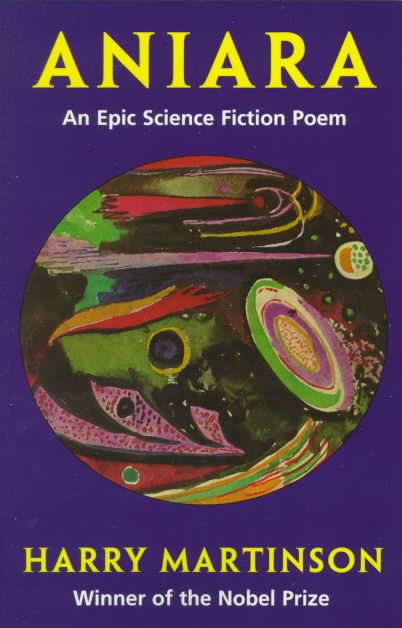8 /10 1 Votes
Originally published 1974 | 4/5 Goodreads | |||||||||||||||||||||||||||||||||
 | ||||||||||||||||||||||||||||||||||
Genres Science Fiction, Speculative fiction Science Fiction books Kallocain, Dune, Nineteen Eighty‑Four, The Handmaid's Tale, Brave New World | ||||||||||||||||||||||||||||||||||
Aniara trailer
Aniara (Swedish: Aniara : en revy om människan i tid och rum) is a poem of science fiction written by Swedish Nobel laureate Harry Martinson in 1956. It was published on 13 October 1956. The title comes from ancient Greek ἀνιαρός, "sad, despairing", plus special resonances that the sound "a" had for Martinson.
Contents
- Aniara trailer
- Karl birger blomdahl aniara 1959 atto i
- Structure and content
- Adaptations
- Translations
- Reception
- References
Aniara is an effort to "[mediate] between science and poetry, between the wish to understand and the difficulty to comprehend." Martinson translates scientific imagery into the poem: for example, the "curved space" from Einstein's general theory of relativity is likely an inspiration for Martinson's description of the cosmos as "a bowl of glass." Martinson also said he was influenced by Paul Dirac.
Karl birger blomdahl aniara 1959 atto i
Structure and content
The poem consists of 103 cantos and relates the tragedy of a space ship (4,750 m (15,580 ft) long and 891 m (2,923 ft) wide) which, originally bound for Mars with a cargo of colonists from the ravaged Earth, after an accident is ejected from the solar system and into an existential struggle. The style is symbolic, sweeping and innovative for its time, with creative use of neologisms to suggest the science fictional setting:
The first 29 cantos of Aniara had previously been published in Martinson's collection Cikada (1953), under the title Sången om Doris och Mima (The Song of Doris and Mima), relating the departure from Earth, the accidental near-collision with an asteroid (incidentally named Hondo, another name for the main Japanese isle where Hiroshima is situated) and ejection from the solar system, the first few years of increasing despair and distractions of the passengers, until news is received of the destruction of their home port (and perhaps of Earth). According to Martinson, he dictated the initial cycle as in a fever after a troubling dream, affected by the Cold War and the Soviet suppression of the 1956 Hungarian revolution; in another version, the first 29 cantos were said to be inspired by an astronomic observation of Andromeda Galaxy.
One of the major themes explored is the nature and necessity of art, symbolised by the semi-mystical machinery of the Mima, who relieves the ennui of crew and passengers with scenes of far-off times and places, and whose operator is also the sometimes naïve main narrator. The rooms of Mima, according to Martinson, represent different kinds of life styles or forms of consciousness. The accumulated destruction the Mima witnesses impels her to destroy herself in despair, to which she, the machine, is finally moved by the white tears of the granite melted by the phototurb which annihilates their home port, the great city of Dorisburg. Without the succour of the Mima, the erstwhile colonists seek distraction in sensual orgies, memories of their own and earlier lives, low comedy, religious cults, observations of strange astronomical phenomena, empty entertainments, science, routine tasks, brutal totalitarianism, and in all kinds of human endeavour, but ultimately cannot face the emptiness outside and inside.
In form, the poems are metrical and mostly rhymed, using both traditional and individual forms, several alluding to a wide range of Swedish and Nordic poetry, such as the Finnish Kalevala.
Adaptations
An opera by Karl-Birger Blomdahl also called Aniara premiered in 1959 with a libretto by Erik Lindegren based on Martinson's poem; it was also staged in Hamburg, Brussels and Darmstadt.
Swedish musician Kleerup released an album based on Aniara in 2012.
A melding of Aniara and Beethoven's opera Fidelio was staged by the Opéra de Lyon under the direction of American artistt Gary Hill in 2013.
The fourth album from the Swedish progressive metal band Seventh Wonder called The Great Escape is based on Aniara.
Translations
Aniara was translated into English as Aniara, A Review of Man in Time and Space by Hugh MacDiarmid and E. Harley Schubert in 1956. It was translated again into English by Stephen Klass and Leif Sjöberg for a 1999 edition. The book is not currently in print.
Reception
Theodore Sturgeon, reviewing a 1964 American edition for a genre audience, declared that "Martinson's achievement here is an inexpressible, immeasurable sadness. [It] transcends panic and terror and even despair [and] leaves you in the quiet immensities, with the feeling that you have spent time, and have been permanently tinted, by and with an impersonal larger-than-God force."
